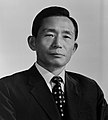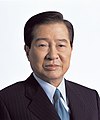
Back بوابة:كوريا الجنوبية Arabic Portal:Cənubi Koreya Azerbaijani دەروازە:کۆریای باشوور CKB Portal:Corea del Sur Spanish Portail:Corée du Sud French Portal:Korea Selatan ID Portale:Corea del Sud Italian 포털:대한민국 Korean Portal:Coreia do Sul Portuguese ද්වාරය:දකුණු කොරියාව Singhalese
 |
환영합니다! / Welcome To The South Korea Portal!  South Korea, officially the Republic of Korea (ROK), is a country in East Asia. It constitutes the southern part of the Korean Peninsula and borders North Korea along the Korean Demilitarized Zone; though it also claims the land border with China and Russia. The country's western border is formed by the Yellow Sea, while its eastern border is defined by the Sea of Japan. South Korea claims to be the sole legitimate government of the entire peninsula and adjacent islands. It has a population of 51.96 million, of which half live in the Seoul Capital Area, the ninth most populous metropolitan area in the world. Other major cities include Busan, Daegu, and Incheon. The Korean Peninsula was inhabited as early as the Lower Paleolithic period. Its first kingdom was noted in Chinese records in the early 7th century BCE. After the unification of the Three Kingdoms of Korea into Silla and Balhae in the late 7th century, Korea was ruled by the Goryeo dynasty (918–1392) and the Joseon dynasty (1392–1897). The succeeding Korean Empire (1897–1910) was annexed in 1910 into the Empire of Japan. Japanese rule ended following Japan's surrender in World War II, after which Korea was divided into two zones: a northern zone, which was occupied by the Soviet Union, and a southern zone, which was occupied by the United States. After negotiations on reunification failed, the southern zone became the Republic of Korea in August 1948, while the northern zone became the communist Democratic People's Republic of Korea the following month. In 1950, a North Korean invasion began the Korean War, which ended in 1953 after extensive fighting involving the American-led United Nations Command and the People's Volunteer Army from China with Soviet assistance. The war left 3 million Koreans dead and the economy in ruins. The authoritarian First Republic of Korea led by Syngman Rhee was overthrown in the April Revolution of 1960. However, the Second Republic failed to control the revolutionary fervor. The May 16 coup of 1961 led by Park Chung Hee put an end to the Second Republic, signaling the start of the Third Republic in 1963. South Korea's devastated economy began to soar under Park's leadership, recording the one of fastest rises in average GDP per capita. Despite lacking natural resources, the nation rapidly developed to become one of the Four Asian Tigers based on international trade and economic globalization, integrating itself within the world economy with export-oriented industrialization. The Fourth Republic was established after the October Restoration of 1972, in which Park wielded absolute power. The Yushin Constitution declared that the president could suspend basic human rights and appoint a third of the parliament. Suppression of the opposition and human rights abuse by the government became more severe in this period. Even after Park's assassination in 1979, the authoritarian rule continued in the Fifth Republic led by Chun Doo-hwan, which violently seized power by two coups and brutally suppressed the Gwangju Uprising. The June Democratic Struggle of 1987 ended authoritarian rule, forming the current Sixth Republic. The country is now considered among the most advanced democracies in continental and East Asia. (Full article...) Selected article - Ulsan (Korean pronunciation: [uɭ.s͈an]), officially the Ulsan Metropolitan City, is South Korea's seventh-largest metropolitan city and the eighth-largest city overall, with a population of over 1.1 million inhabitants. It is located in the south-east of the country, neighboring Busan to the south and facing Gyeongju to the north. Ulsan is the industrial powerhouse of South Korea, forming the heart of the Ulsan Industrial District. It has the world's largest automobile assembly plant, operated by the Hyundai Motor Company; the world's largest shipyard, operated by Hyundai Heavy Industries; and the world's third largest oil refinery, owned by SK Energy. In 2020, Ulsan had a GDP per capita of $65,352, the highest of any region in South Korea. (Full article...)Selected image Girls' Generation (Korean: 소녀시대; RR: Sonyeo Sidae), also known as SNSD, is a South Korean girl group formed by SM Entertainment. Its nine original members were (pictured, from left to right): Taeyeon, Hyoyeon, Seohyun, Sooyoung, Yoona, Jessica, Tiffany, Sunny, and Yuri. Jessica later departed from the group in September 2014. More did you know -
In the news
This is a Good article, an article that meets a core set of high editorial standards.
The Battle of Kapyong (Korean: 가평전투; 22–27 April 1951), also known as the Battle of Jiaping (Chinese: 加平战斗; pinyin: Jiāpíng Zhàn Dòu), was fought during the Korean War between United Nations Command (UN) forces—primarily Canadian, Australian, and New Zealand—and the 118th and 60th Divisions of the Chinese People's Volunteer Army (PVA). The fighting occurred during the Chinese Spring Offensive and saw the 27th British Commonwealth Brigade (27th Brigade) establish blocking positions in the Kapyong Valley, on a key route south to the capital, Seoul. The two forward battalions—the 3rd Battalion, Royal Australian Regiment (3 RAR) and 2nd Battalion, Princess Patricia's Canadian Light Infantry (2 PPCLI), both battalions consisting of about 700 men each—were supported by guns from the 16th Field Regiment (16 NZFR) of the Royal Regiment of New Zealand Artillery along with two companies of US mortars, fifteen Sherman tanks from US 72nd Heavy Tank Battalion, two companies of the US 74th Engineer Combat Battalion and 1st Battalion, Middlesex Regiment. These forces occupied positions astride the valley with hastily developed defences. As thousands of soldiers from the Republic of Korea Army (ROK) began to withdraw through the valley, the PVA infiltrated the brigade position under the cover of darkness, and assaulted the 3 RAR on Hill 504 during the evening and into the following day. Five companies of the US and UK forces attached to 27th Brigade fled the battlefield without orders, expecting an imminent PVA breakthrough at the Kapyong Valley. Although heavily outnumbered, the 3 RAR and U.S. tanks held their positions into the afternoon of April 24 before they retreated from the battlefield to a reserve position near brigade headquarters, with both sides having suffered heavy casualties. The PVA then turned their attention to the surrounded 2 PPCLI on Hill 677, whose encirclement prevented any resupply or reinforcements from entering. The 2 PPCLI were ordered to make a last stand on Hill 677. During a fierce night battle on 24/25 April the PVA forces were unable to dislodge the 2 PPCLI and sustained enormous losses. The next day, the PVA withdrew back up the valley in order to regroup, and the 2 PPCLI were relieved late on 26 April. The fighting helped blunt the PVA Spring Offensive and the actions of the 2 PPCLI and 3 RAR at Kapyong were critical in preventing a breakthrough against the UN central front, the encirclement of US forces in Korea, which were at that point in general retreat, and ultimately, the capture of Seoul. The 2 PPCLI and 3 RAR battalions bore the brunt of the assault and stopped PVA divisional forces estimated at 20,000 in strength during the hard-fought defensive battle. Today, the battle is regarded as the most famous and significant action fought by the Canadian and Australian armies in Korea, and the most famous battle fought by the Canadian Armed Forces since WWII. (Full article...)General images -The following are images from various South Korea-related articles on Wikipedia.
Did you know (auto-generated)
WikiProjectsSee WikiProject Korea for collaborating on South Korea topics, and more broadly, on all things Korea-related. South Korea topics
CategoriesAdministrative divisions of South Korea
Related portalsEast Asia Associated WikimediaThe following Wikimedia Foundation sister projects provide more on this subject:
Web resources
SourcesDiscover Wikipedia using portals |
© MMXXIII Rich X Search. We shall prevail. All rights reserved. Rich X Search























































